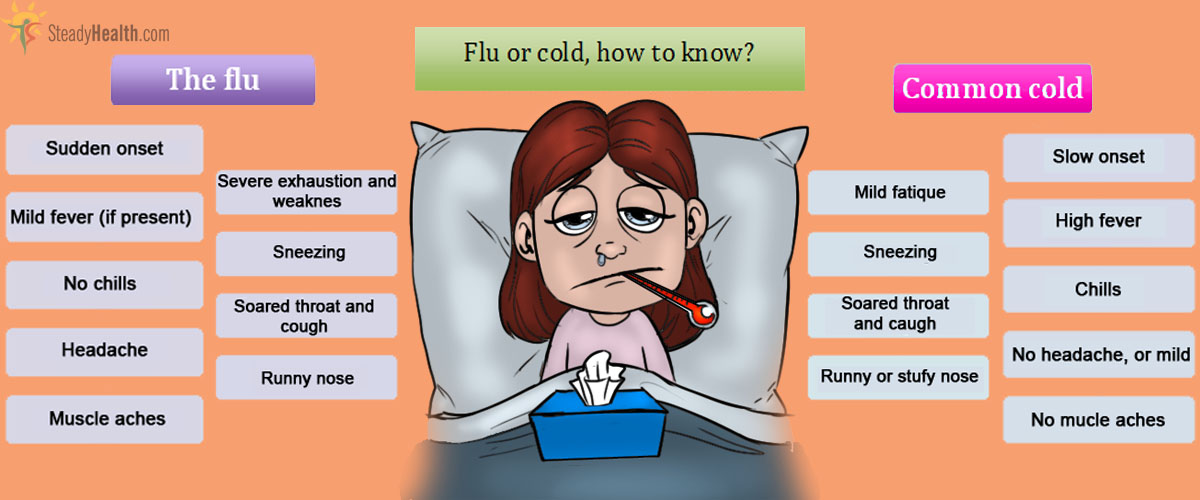What is what?
Feeling as if you've caught a cold? Or is it the flu? What is the difference between both? This is always tricky to say. People usually come into the doctor’s office, refer their symptoms and tend to use both terms, cold and flu, interchangeably, to describe a state of tiredness, soared throat and runny or stuffy nose, cough, headaches and sometimes, fever.
What is the reason behind this? Well, both the cold and the flu are viral infections, but they are caused by different viruses. Rhinoviruses, coronaviruses and adenoviruses are the ones that cause the common cold, while influenza virus is the one to blame for the flu.
Common cold
Common cold viruses are present in microscopic droplets that wonder around us, in the air and surfaces. When they enter into our body, common cold viruses usually affect the upper respiratory tract, causing stuffy or runny nose, soared throat and cough and sneezing. The onset of the cold symptoms is slow. Normally, you will start feeling sick during the first two or three days of the infection, and it won’t be too long before the symptoms disappear and you feel better. It can take about one or two weeks for all the symptoms to disappear, without any other consequences.
You can also use some natural remedies, including drinking orange juice or taking vitamin C supplements to strengthen your immune system; herbal teas and honey, to relieve throat soreness and inflammation, and many others.
See Also: Difference and connection between FLU and COLD?
The flu
The flu, on the other hand, happens suddenly, or acutely, as the doctors say, affecting also the upper respiratory tract.
Do you remember the last influenza epidemics? Well, not every influenza infection is as dangerous as the A (H1N1), which is the one that caused the epidemics a few years back. Actually, influenza viruses are present in the environment, but they tend to infect people during specific times of the year, due to changes in weather and vulnerability of our immune system.
More About The Influenza Virus
Seasonal influenza or seasonal flu shares some of the symptoms of the common cold, but they tend to be more intense and resolve a bit slower. While fever may or may not be present during a cold, high fever is a common characteristic of an influenza infection. Also, tiredness and headaches are more severe and make patients incapable of performing their daily activities.

Hospitalization can be required if the infection gets worst, in order to avoid the development of other respiratory problems, such as pneumonia or bacterial infections. You have to take extra care when you suspect a child or an older person has the flue. They are what doctors refer to as part of the population at risk because their immune system may not be well enough to fight against the virus, and may respond with a severe symptomatology.
Flu treatment and the anti-influenza vaccine
Flu treatment relies on antivirals, but they are only effective when prescribed during the first days of the infection. After that, your doctor may only prescribe medication to relieve some of the symptoms and an antibacterial, if the disease has progressed to a bacterial infection.
There is an influenza vaccine available now for the general public. It was created to prevent both seasonal and other types of influenza infections, including the one that was caused by the A (H1N1). Since there are many subtypes of the influenza virus, the vaccine doesn’t protect you against all of them, but it does against the most common and most dangerous.
The vaccine helps you develop antibodies, which are like small soldiers, that recognize the virus and prevents it from infecting your cells or helps in the destruction of the already infected ones.
See Also: Is It a Cold, or Is It Flu? When Are You Too Sick to Work Out?
Staying healthy
It is easy to prevent catching a cold or the flu. Try to always cover both your nose and your mouth to avoid your respiratory tract to be affected by low temperatures, specially during the cold season. Drink plenty of fluids during the day and include citric fruits in your diet, or take vitamin C supplements. Avoid crowded areas and if you start feeling sick, stay at home to prevent the virus from spreading to others and visit your doctor as soon as you can.
Proper and frequent handwashing with soap and water for at least 20 seconds is essential. If soap and water aren’t available, using a hand sanitizer with at least 60% alcohol can also help. It's crucial to avoid touching your face, especially the eyes, nose, and mouth, without clean hands.
Regularly disinfect commonly touched objects and surfaces, like doorknobs, phones, and keyboards. Viruses can survive on surfaces for a varying amount of time, and regular disinfection can limit their spread. Especially during the dry winter months, maintaining indoor humidity around 40-60% can be beneficial. Viruses tend to survive less effectively in humid environments. Moreover, keeping mucous membranes moist can help ward off infections.
Some people swear by nasal irrigation, like using a neti pot, to flush out viruses and bacteria from the nasal passages.
You may require further tests to see whether it is just a cold or if it is something else, but be patient. Sometimes, self-medicating can shadow important symptoms that could help your doctor in your diagnosis. If you hide them with medications, it will be harder to know what’s making you feel sick.
- Mindmap by steadyhealth.com
- Photo courtesy of Phil and Pam Gradwell (to be) by Flickr : www.flickr.com/photos/philandpam/2703706813/


